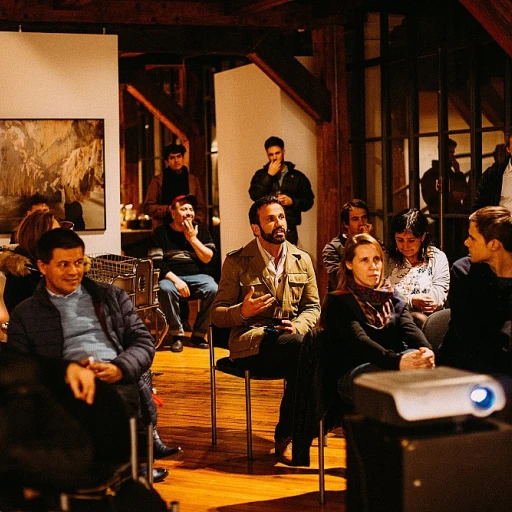
Understanding Fully Immersive VR
Defining the Enigma of Full Immersion
The realm of virtual reality (VR) continues to fascinate us with its immersive potential. But what does it truly mean to have a 'fully immersive' experience? In the heart of the conversation lies the convergence of virtual environments and our sensory perceptions to create a real time, all-encompassing experience. In contrast to traditional VR setups, which rely heavily on visual and auditory stimuli, fully immersive VR aims to incorporate a wider range of senses in a coordinated manner. Imagine stepping into a digital space that feels as tangible as real life. Whether it's walking through ancient ruins, diving deep into oceans, or even exploring a bustling virtual metropolis, the objective is to blur the lines between reality and digital immersion. Augmented reality and mixed reality are other technologies contributing to this evolution, enhancing real-world experiences with digital overlays. Currently, most virtual reality setups offer partial immersion by delivering content through headsets and controllers. The jump to full dive virtual environments requires advancements in sensory feedback, brain-computer interfaces, and spatial mapping, which will be discussed in detail in further sections of this article. The aspiration is to replicate a reality virtual enough that users feel fully integrated into the digital landscape. While video games and immersive learning applications are making strides in this direction, the full realization of a Ready Player One-style experience still eludes us. For those eager to explore further, the concept of a metacity and its implications on virtual environments may provide additional insights into our journey towards full immersion: discover more about the concept of a metacity. As we stand at the crossroads of science fiction and technological reality, it's crucial to understand where we are today to map the advances needed for tomorrow. The coming years hold immense potential, spurred by rapid advancements in digital and immersive technology, setting the stage for truly transformative experiences.Technological Advancements Needed
Technological Foundations for Full Immersion
The journey towards fully immersive virtual reality is a complex one, requiring significant advancements in several key areas of technology. To achieve a full dive experience where users feel as if they are truly part of a virtual environment, we must first understand the components that make this possible. Immersive technology aims to bridge the gap between the real world and virtual environments, creating experiences that are indistinguishable from real life.
Hardware Innovations
One of the primary technological advancements needed is in the realm of hardware. Current virtual reality headsets are bulky and can be uncomfortable for extended use. For a full immersion experience, we need devices that are lightweight, wireless, and capable of rendering high-resolution graphics in real time. Moreover, advancements in haptic feedback technology are essential to provide users with a sense of touch and interaction within the virtual space.
Software and Processing Power
Equally important is the software that powers these immersive experiences. The development of sophisticated algorithms and AI that can simulate real-life scenarios with high fidelity is crucial. Additionally, the processing power required to support these simulations must be substantial. This means leveraging advancements in cloud computing and edge computing to ensure seamless and lag-free experiences.
Neuroscience and User Experience
Understanding the human brain's interaction with virtual environments is another critical factor. Research in neuroscience can help us design immersive experiences that are not only realistic but also safe and comfortable for users. This involves studying how the brain perceives virtual reality and ensuring that the content is engaging without causing discomfort or motion sickness.
For more insights into the role of technology in creating immersive learning environments, you can explore harnessing educational technology for virtual laboratories.
Current Progress and Innovations
Current Progress and Innovations in Immersive Virtual Reality
The journey towards achieving a fully immersive virtual reality experience has seen significant strides, bridging the gap between what was once considered science fiction and what we can now touch and feel. The current progress and innovations in immersive technology are paving the way for a deeper dive into virtual environments, creating experiences that mimic real life.
One of the key factors enabling this progress is the integration of real-time processing capabilities with high-fidelity graphics. Technologies are advancing to ensure that users don't just see the virtual world but genuinely feel immersed within it. For example, improvements in haptic feedback devices allow users to experience physical sensations in virtual environments, enhancing the immersion.
Moreover, augmented reality and mixed reality technologies are becoming more sophisticated and accessible. These developments are eliminating the lines between the physical and digital spaces, enabling a seamless transition and interaction between the two. Augmented reality applications in immersive learning and video games are offering more dynamic interactive experiences, where the real and virtual worlds coexist harmoniously.
Companies are investing heavily in developing immersive virtual content, which is a crucial component to ensure engaging and meaningful experiences. This content generation extends from video games to educational platforms, promoting a more engaging and personal interaction for the users. By harnessing these advancements, immersive experiences are becoming more prevalent and realistic, making full immersion an achievable reality within the next few years.
These technological advancements are already starting to impact various sectors. For instance, the workplace is evolving under the influence of virtual reality, optimizing environments and fostering enhanced collaboration. As we continue to make progress, we can expect a transformation in how people will work, play, and learn.
By keeping abreast of these innovations, businesses can better prepare for the integration of these technologies into everyday operations, ensuring they remain competitive in an ever-evolving digital landscape. For more insights on how the workplace is adapting to these new technologies, explore our detailed article on enhancing workplace intelligence for tomorrow's challenges at Future of Work blog.
Challenges and Barriers
Obstacles on the Path to Total VR Integration
The journey toward achieving fully immersive virtual reality is filled with significant challenges that need addressing. Although we've seen substantial progress in immersive technologies and virtual environments, we're still far from realizing the "full dive" experience often depicted in science fiction. One persistent hurdle is the development of sophisticated hardware required to deliver real-time, life-like experiences. Creating devices that can stimulate all the human senses simultaneously, including touch, taste, and smell, remains a formidable challenge. This type of sensory experience is crucial for true immersive learning and training environments. For instance, while some headsets can deliver high-quality visual and audio immersion, they fall short in encompassing other senses, limiting the overall experience. Another barrier is the computational power needed to simulate a reality virtual enough to fool the human brain. Real-time rendering of complex virtual environments demands significant processing power, far beyond what current consumer devices are capable of reliably delivering during continuous use. Developing this capability requires advancements in both hardware and software to ensure seamless user experiences without motion sickness or other discomforts. The content available for these immersive experiences is another area needing growth. While video games and experimental content offer glimpses into immersive technology potential, the breadth and quality of what users can dive into remains limited. Creating engaging, interactive content that people will feel compelled to experience will drive greater adoption of immersive technologies. Moreover, integration with existing technology platforms presents another challenge. Ensuring compatibility and ease of use across devices and platforms is critical if immersive virtual reality is to be embraced for both work and leisure. Finally, societal and ethical implications also pose significant hurdles. These range from privacy concerns to the mental and physical effects of prolonged immersion in virtual environments. Addressing these concerns transparently will be crucial for widespread acceptance and use. The road to fully immersive VR demands collaboration across various sectors and continued investment in both technology and human-centric design. While we're not there yet, the evolution of this field promises transformational potential for real-life applications in the future of work.Impact on the Future of Work
The Transformation of Job Roles and Skills
The impact of fully immersive virtual reality (VR) on the future of work is set to be profound, reshaping job roles and the skills required. As immersive technology matures, the transition from current work patterns to those driven by immersive experiences will require significant adaptation. This transformation is reminiscent of how the internet revolutionized communication and commerce.
With the integration of immersive virtual environments, roles will evolve to include new responsibilities focused on creating, managing, and optimizing VR content. Professionals may find themselves working in fields that combine elements of the digital and physical realms, often referred to as mixed reality environments. This could see a rise in demand for skills relating to immersive learning tools, which facilitate real time, engaging education experiences.
Industries Embracing Immersive Technology
Various industries are already beginning to embrace aspects of fully immersive VR. For example, the video game industry, traditionally a pioneer in technology, continues to push the boundaries of immersive experiences, striving towards full immersion that mimics real life sensations. Moreover, sectors such as training and development are increasingly utilizing VR environments for immersive learning, allowing people to practice skills in safe yet realistic settings.
The healthcare sector stands to benefit immensely from immersive technology, as health professionals can dive into highly detailed virtual scenarios for training purposes. The use of full dive VR could revolutionize surgical training, providing a risk-free platform where scenarios can be repeated until proficiency is achieved.
Potential Challenges and Opportunities
However, the adoption of fully immersive VR poses challenges. Ensuring equitable access to this technology across various socioeconomic groups is critical to prevent a digital divide. Organizations will also need to consider the physical and cognitive impacts of prolonged VR use on the user's brain and overall well-being.
Despite these challenges, augmented reality and immersive virtual environments present opportunities to reimagine work. As these technologies integrate further, organizations must strategize on how to leverage VR for workforce development, immersive training, and the creation of more engaging, efficient work processes.
As we continue to explore immersive technologies, the years ahead promise a thrilling journey into realities that not long ago seemed like science fiction.
Predictions and Timelines
Projecting the Evolution
The journey towards fully immersive virtual reality (VR) not only promises an enhanced user experience through augmented realities but also holds significant potential for reshaping the future of work. As individuals increasingly seek fully immersive technology solutions, it's crucial to consider how these developments will change professional dynamics and practices.- Immersive Work Environments: The real-time interaction with immersive environments is expected to transform office spaces. Virtual environments will allow for a full dive into hybrid workspaces where people will feel as though they are interacting with real-life colleagues and clients, fostering a more collaborative atmosphere even from afar.
- Virtual Reality in Training and Development: Immersive learning tools will be utilized in training programs, increasing engagement and improving skill acquisition. Such full immersion experiences are likely to replace traditional training methods, with content tailored to recreate real-world scenarios that enhance user understanding.
- Remote Work and Mixed Reality Integration: The combination of augmented reality with immersive technology will lead to a blend of physical and digital workspaces. People will operate within this mixed reality landscape, enabling interactions that feel more natural despite physical distance. Remote work might witness heightened adoption as immersive technologies evolve.












